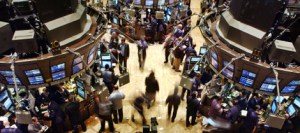Morning Briefing

September 30, 2022 | Daily JAM, Morning Briefing |
The Personal Consumption Expenditures index, the Federal Reserve’s preferred inflation measure, rose in August. The index climbed 0.3% from July. Year over year the PCE is up 6.2%. Excluding food and energy, the core PC index rose 0.6% in August from July and at a 4.9% year-over-year rate.
Both the headline and core numbers showed a month-to-month acceleration in inflation. That’s bad news for the Federal Reserve, investors, and consumers since it indicates that inflation is stickier than hoped and that it will take the Fed longer to bring inflation down to its 2% target. This ratchets up the importance of the Consumer Price Index for September with that inflation number due on Thursday, October 13.

September 29, 2022 | Daily JAM, Morning Briefing |
Yesterday, September 28, for a day, global stocks and bonds rallied after the Bank of England stepped in and said it was setting aside £65bn ($72 billion) to buy bonds over the next 13 working days. (It’s a limited-time offer that expires on October 14.) Today, the global selling has resumed. As of the close in New York time, the Standard & Poor’s 500 was down 2.11% on the day. The rally yesterday was, in my opinion, a knee-jerk reaction by investors and traders who saw the Bank of England’s move as evidence that the central bank Put lived. And that central banks would, of course, rescue the financial markets. According to this interpretation, the market was upset, and, as usual, central bankers soothed it with a bundle of cash. Which led markets to hope that other central banks, especially the Federal Reserve, would pivot away from a policy of higher interest rates in the face of the damage done to financial markets. Today’s resumption of selling is, I think, a recognition that yesterday’s rally was based on false assumptions.

September 28, 2022 | Daily JAM, Jubak Picks, Morning Briefing, Top 50 Stocks |
Apple (AAPL), which once urged suppliers to increase production of its new iPhone, is now telling them “Never mind,” according to Bloomberg. The anticipated surge in demand has failed to materialize. the company had told suppliers to increase production in the second half of the year ahead of a projected increase in iPhone sales in the second half of 2022. Now Apple is aiming to produce 90 million iPhones in the period. That’s roughly the same level as in the second half of 2021 and in line with Apple’s original forecast this summer.

September 26, 2022 | Daily JAM, Morning Briefing |
There’s now $4.6 trillion stashed in US money-market mutual funds. Ultra–short bond funds currently hold about $150 billion. And the pile is growing. Cash saw inflows of $30 billion in the week through September 21, according to figures from EPFR Global. In addition there’s another $18 trillion in deposits at U.S. commercial banks, according to Federal Reserve data. U.S. banks are sitting on about $6.4 trillion of surplus liquidity, or excess deposits relative to loans, up from about $250 billion in 2008. The flows are being driven by two factors

September 23, 2022 | Daily JAM, Morning Briefing |
Yes, the Federal Reserve got a lot more pessimistic on economic growth, inflation, and interest rates in the Dot Plot projections released on Wednesday, September 21. For instance, the Fed’s median projection for real growth in the U.S. economy for 2022 dropped to 0.2% the year to year in the fourth quarter of 2022 from 1.7% in the June projections. And for 2023 the Fed’s projections dropped to an annualized rate of 1.2% in the fourth quarter from an earlier projection of 1.7%. But the Fed is still a firm believer in fairy tales. That of Goldilocks, specifically, where the economy and Fed policy turn out to be “just right.”

September 23, 2022 | Daily JAM, Morning Briefing |
Posting the news about the Fed and inflation–plus posting about what it all means for the market–has soaked up the bulk of my time this week. Which has left me behind the 8-ball on lots of other important stuff. But I’m going to try to catch up over the next few days with:

September 22, 2022 | Daily JAM, Morning Briefing |
One of the oddest things about yesterday’s reaction to news from the Federal Reserve of a 75 basis point increase in interest rates was that the market initially rallied. Yesterday, September 21, from 3801 at 10:25 a.m.New York time, the Standard & Poor’s 500 moved up to 3895 at 2:40 p.m. right after the Fed released its news. And, then, markets began a retreat with the S&P 500 closing down 1.71% on the day. It’s almost like the markets constructed one story–relatively positive–in the immediate aftermath of the news. And, then, upon further consideration, built a different much less positive story to the close of the day. Make that “exactly” instead of “almost like.”

September 21, 2022 | Daily JAM, Morning Briefing |
Faced with the alternative of admitting that recent Ukrainian counter-attacks have sent Russia’s military reeling, Russian President Vladimir Putin has decided to up his game in Ukraine. So far, today, the markets remain focused on the meeting of the Federal Reserve and the U.S. central bank’s decision on interest rates. But I’d try to spare a few brain cells for the likely effects on commodities such as wheat and natural gas from these signs of escalation. Europea natural gas inventories are now at 86% full, just above the 5-year average. That suggests that gas prices will move higher but that this winter won’t see widespread shortages and prices. I think it’s likely to be another story for prices in 2023 when European countries need to scramble to refill these reserves. I own U.S.Natural Gas Fund ETF (UNG) and the Teucrium Corn Fund ETF (CORN) and Teucrium Wheat Fund ETF (WEAT) in my online portfolios. I own all three in my personal portfolios.

September 20, 2022 | Daily JAM, Morning Briefing |
You’d think that if everyone (maybe even Samuel Beckett) is expecting the Fed to raise interest rates 75 basis points at tomorrow’s meeting of the Open Market Committee, financial markets would have been able to move on today to other “issues.” (Like Ford’s huge negative earnings pre-announcement or the global supply crunch for coffee. The CME FedWatch Tool today puts the odds of a 75 basis point increase at 84%. The other 16% goes to a 100 basis point increase. Nobody is expecting just 50 tomorrow. But no. Stocks and bonds are lower but it feels like markets are just marking time.

September 16, 2022 | Daily JAM, Morning Briefing |
Yesterday, September 15 FedEx (FDX) preannounced a huge miss for the upcoming quarter (due to be reported on September 22) and withdrew its guidance for the full year. Researchers at Deutsche Bank said that it’s the worst report they’ve seen in two decades. “FedEx preannounced last night the weakest set of results we’ve seen relative to expectations in our ~20 years of analyzing companies,” the company’s analysts wrote in a note to clients.

September 15, 2022 | Daily JAM, EVGO, Millennial, Morning Briefing, Volatility |
Wednesday, September 14, President Joe Biden used a visit to the Detroit Auto Show to announce the release of the first $900 million in funding for the buildout of a national network of charging stations for electric vehicles. The funding, part of $7.5 billion in the Infrastructure bill to build out a network of 500,000 charging stations, would go to 35 stations to build charging networks along 53,000 miles of highways. Today, the sector is moving up rapidly with ChargePoint up 8.60% and EVgo up 12.16% as of 2:30 p.m. New York time.

September 14, 2022 | Daily JAM, Morning Briefing |
Investors and traders have decided not to panic today. Which certainly wasn’t the case yesterday. I’ll leave it to you to decide if a 5.54% drop in the NASDAQ 100 is a measured reaction to inflation running 20 basis points hotter than projected. (Amazon (AMZN) fell 3.06%, Apple (AAPL) was down 5.87%, Applied Materials (AMAT) was lower by 6.14%, and Nvidia (NVDA) plunged 9.47%.) But I sure caught a whiff of panic in Wall Street calls for the Federal Reserve to raise interest rates by a full 1.00%–and not the widely anticipated–0.75% at the September 21 meeting of the Open Market Committee.















